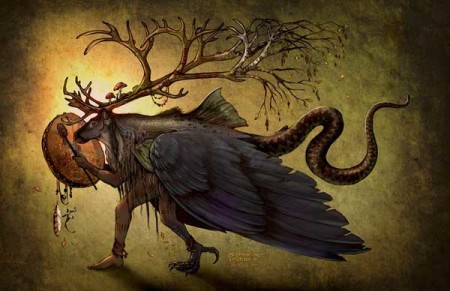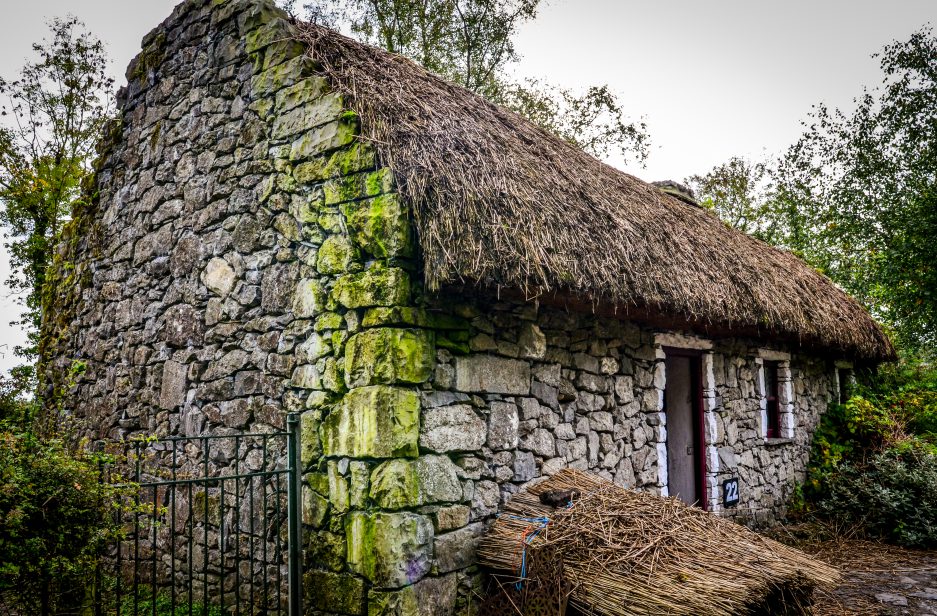
Dogs have always been seen as not only loyal companions but also as protectors of both our homes and livestock and were historically used in times of war and also in helping with hunting. The majestic wolfhound, the oldest Irish breed was once a status symbol owned only by Kings and as their names suggests, used for hunting the wolves that once roamed our country. So, it is no surprise that with our close relationship with the hound, that it finds a prominent place in our Folklore, myths and legends. Both in Ireland and UK we share the belief that dogs are capable of seeing supernatural beings and I have many memories of being told that a dog was seeing a spirit when it was staring off into space intently, but was always assured it meant no harm if the dog was not scared. The belief that the dog could protect against the influences of the otherworld is by no means a new belief and in the Brehon laws we see that anyone who killed a dog belonging to a woman who was in labour, had to pay for a priest to stand over the woman and read the scriptures, day and night, until the labour was over to keep her safe from otherworldly influences (MacCoitir,2010:188).
Supernatural Dogs

Not only do we find that they could see spirits, or fairies, but it was also a belief that they themselves could become ghosts. We see an example of this in the National Folklore Schools collection (hereafter NFSC) in a story collected by Michéal Ó Gealbháin called “A Dog’s Ghost”. The story tells of how the informant once had a dog he was very attached to, as was the dog to him. One day as he was returning from a trip to Castlebar he seen the dog running up the road to meet him. As he drew closer the dog seemed to disappear into the bushes and would not come when he called him. Assuming the dog had just followed a rabbit he continued on home. Upon reaching the house he remarked to his wife how the dog would not come home when he called and that he would have to go and find him. His wife put down her knitting and placing a hand on either shoulder, said to him “You must be brave” and after a no doubt dramatic pause, said “The dog is dead”. He knew by the sorrowful look in her eyes that she was not joking and after following his wife to stables found the dog lying dead on the floor. The dog had passed away shortly after he had left for Castlebar earlier that morning. (NFSC, Vol:0095:167). This story brings to mind similar accounts found throughout Irish Folklore of the ‘fetch’ of a person appearing to loved ones around the time of their death.
In some areas of the country we find that a baying hound, called a gaidhrín caointeach replaced the infamous Bean Sídhe (banshee) as the herald of death for certain families such as the O’keeffe’s in West Cork. We also find a tradition/ variation in Ireland akin to the hounds of hell archetype where it is believed that these death hounds awaited the soul after death in so any morsels of bread would be thrown out in an effort to entice the dogs away as the person lay dying (MacCoitir,2010:95).
In terms of supernatural dogs, we also find a proliferation of accounts of monstrous black dogs, often encountered by people who wonder about too late at night (In fact a cursory glance at the duchas.ie page turns up well over 100 dog related entries, the vast majority of which are black dog stories). They are often spotted near Ringforts (often called rath or Lios), the medieval enclosure dwellings that dot the landscape. These monuments, as many will know, are considered the abode of the ‘Good people’, the fairies, and are still treated by many with respect and superstition or even fear. Eddie lenihan, the well respected Seanchaí and expert in fairy lore, tells us how these black dogs are the “frequenters and protectors” of fairy sites such as their dwellings and pathways. He tells us how the same dog, although not always a danger to people if left alone, can be seen over several generations in the same location and is often immobile and massive in size but just watches menacingly (lenihan,2003:89). Sometimes this ghostly black dog is connected with hidden treasure as we see in the following tale found in the NFSC: One evening as a boy was returning home from a fair, he met with a big black dog with “blazing eyes”. The dog leaped over a big gate into a bunch of nettles and disappeared. The boy recounted the story to his father and they both returned to the site with a shovel and after digging on the spot where the dog had vanished, found a box full of money (NFSC,Vol.0647:345). The black dog archetype is a migratory myth found in many lands outside of Ireland and is very popular in the British Isles but in the course my research for this article I came across an interesting find. In a story named “The Fairy Dog” in the NFSC we see an interesting account of a red dog (NFSC,Vol.0007:81). The colour red seems to me tosignify it as an otherworldly animal as we often find otherworldly cows and deer, usually white in color with red ears, so I believe in the case the colour red may be used to point out its otherworldly origins. At the very least it is interesting in the fact it varies from the usual black dog with burning red eyes. For any interested in the UK variation of the black dog mythos, I would suggest checking out the work of Mark Norman here: http://www.troybooks.co.uk/black-dog-folklore.html
Transformation

When looking at Irish myth and folklore we find many instances of people transforming into animals. We see from some of our earliest literature that there was a druidic belief, something akin to reincarnation or rebirth where they thought that their ancestors “flew through the ages in the shape of birds”. This belief carried forward into the Christian era and we also see a multitude of instances of people who shapeshift in the form of one animal or another. We see long lived characters such as Tuán MacCaraill and Fintan son of Bochaire who survived thousands of years through shapeshifting into different animals and we also see similar events in the Lives of saints such as Saint Patrick and of course who could forget the children of Lir. So, it is no surprise considering the closeness and importance of humble dog, or Madra in Irish, that it would feature in similar shapeshifting stories. Two of these stories, found in the NFSC are due to enchantment by witches. In the “White Dog of the Valley” (NFSC,Vol.0442:071) we see a man who changes into a dog to steal the kings cattle and in “The Green Dog of the Woods” (NFSC,Vol.0222:023) we see a similar story when a man is under a spell that causes him to take on the form of a dog every evening.
Influence of Dogs on Names and Their Links With Heroes

We also see, because of the importance of dogs to the Irish, that they had an influence on Irish names. We see names such as Conn (such as Conn Céadcathach / Conn of the Hundred Battles) ,Conchobar (Conor) and Conall that derive from the word Cú/con meaning “hound, wolf” and of course one could not forget to mention the premier hero of the Irish mythological tradition, Cúchulainn. Originally named Setanta, he earned his name from killing the infamous, ferocious hound of the smith Culainn when arriving late to a dinner he was invited to by the king Conchubar,at the home of the smith. From that day forward he was known as Cúchulainn (the hound of Culainn) as he acted as protector in place of the hound till another could be trained to take his place. Because of his links with Dogs he also had a Geas (A taboo or obligation, often magically imposed) that forbid him from eating the flesh of a dog. Traditionally, the doom of heroes comes about due to their violation of their geas, either by accident, or by having multiple geasa and then being placed in a position where they have no option but to violate one geas in order to maintain another. For instance, The champion Cúchulainn came across three old crones roasting a hound on rowan spits. They asked him to partake in their humble meal, but there was a geas on Cúchulainn forbidding him to eat the flesh of the hound (his totem animal) and also against eating meat cooked over an open fire. Cúchulainn at first refused to eat the meat, but the crones persisted saying ‘you are too proud to eat an honest meal from a few old women but will feast on rich foods in the halls of chieftains and kings.’ Then Cúchulainn took the meat in his left hand – going against the double taboo and as soon as he ate the food he was paralyzed in the left side of his body, which hastened his inevitable demise in the forthcoming battle
We also see dogs feature in the Finnaíocht tradition of Irish mythology, that is the stories concerning Fionn MacCumhaill (Finn MacCool) and his roving warband, the Fianna. These legends tell us of Finn’s favourite dog Bran, a dog thought to possess great knowledge and sense who often helped Finn or saved him from danger. The Birth of both Bran and Sceoling (another hound of the Fianna) falls under the category of transformation above. Both were born to a queen who had been transformed into the form of a dog by a sorceress and who gave birth to them while in this form. In The Lay’s of Finn we find a poem that tells the story of Bran, with Fionn praising him (MacCoitir,2010:99).
This is but a short summary of how dogs factor in on Irish Folklore. I hope you enjoyed this introduction to the subject and I hope to bring many more segments to my animal folklore series in the future. If you would like to read some of the Schools collection for yourself follow this link to read the entries on dogs: http://www.duchas.ie/en/src?q=dog&t=CbesStory and don’t forget to follow my page on facebook : https://www.facebook.com/Irishfolklore/
Bibliography
NFSC.Vol:0095:167, collector: Michéal Ó Gealbháin, Informant: Mr.Morony, Clogher, Co. Mayo.
NFSC,Vol.0647:345, Collector: Tomás Ó Dúnaighe, Informant: Tom Dwyer, Ballynamult, Co. Waterford.
NFSC,Vol.0007:81, Collector: Joseph King, Informant: Thomas King (50), Farmer, Roundstone, Co. Galway.
NFSC,Vol.0222:023, Collector: Joseph Quinn, Cloone, Co. Leitrim.
NFSC,Vol.0442:071, Collector: Nellie Doyle, Informant: Nóra Ní Shuilleabháin.
Lenihan, E, 2004. Meeting the Other Crowd. TarcherPerigee
MacCoitir.N,2010, Ireland’s Animals: Myths, Legends and Folklore, Collins press.
